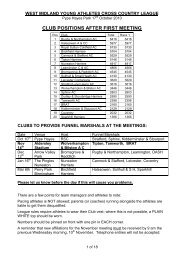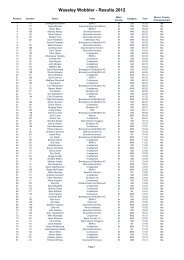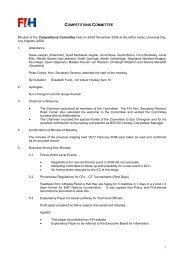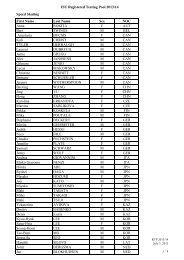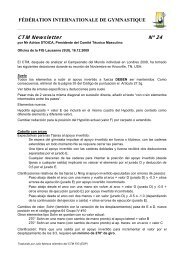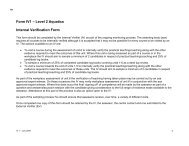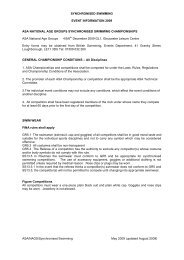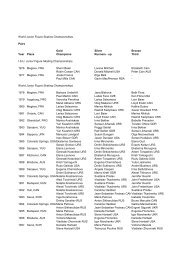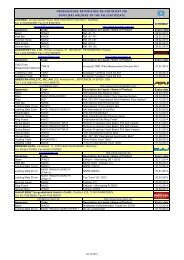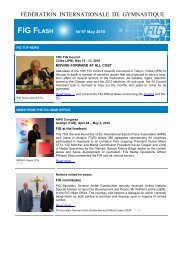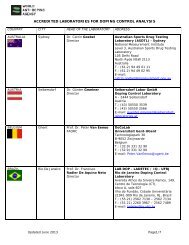ASA/UKCC Level 2 Certificate for Coaching Diving - FIG
ASA/UKCC Level 2 Certificate for Coaching Diving - FIG
ASA/UKCC Level 2 Certificate for Coaching Diving - FIG
Create successful ePaper yourself
Turn your PDF publications into a flip-book with our unique Google optimized e-Paper software.
Unit 1 – Health and Safety (Core to all <strong>Level</strong> 2 qualifications)Overview of Unit 1This is a mandatory unitThis is a core unit and links across all strands of <strong>UKCC</strong> (Aquatic Teaching, <strong>Diving</strong>, Swimming<strong>Coaching</strong>, Synchronised Swimming and Water Polo). This unit explores the issues of Health andSafety relating to a <strong>Level</strong> 2 Teacher/Coach.AssessmentThis element will be assessed through written examination of 30 minutes duration.Element 1To achieve this element the candidate must be able to:U1.1.1 Identify the common components and uses of Pool Safety Operating Procedures (PSOP)U1.1.2 Identify the components and uses of a risk assessmentU1.1.3 Identify relevant Health and Safety regulations relating to the <strong>Level</strong> 2 Teacher/CoachU1.1.4 Explain the appropriate procedures <strong>for</strong> dealing with injury, illness and accidentsU1.1.5Identify appropriate readiness factors of participants and self-relating to the safeteaching/coaching of sessionsU1.1.6 Identify appropriate standards of behaviour <strong>for</strong> participantsU1.1.7 Explain organisational guidelines to protect children and vulnerable adults from abuseSyllabus:Control and Preventative Measures:• Components of a PSOP: e.g. - previous risk assessments, safe activities on and off site,reporting procedures, managing participants’ needs• Uses of a PSOP: procedures <strong>for</strong> setting up and putting away equipment e.g. - lane ropes,Water Polo nets, springboards• Relevant Regulations <strong>for</strong> Health and Safety <strong>for</strong> the <strong>Level</strong> 2Teacher/Coach: Health & Safetyand Work Act 1974• Components of a Risk Assessment: types of hazards: e.g. - resources, equipment, facilities,environment, participants and others; evaluation of risk• Uses of a Risk Assessment: planning <strong>for</strong> safe sessions, reducing operational risk andreviewing safety policies.Health and Safety Responsibilities of Self, Participants and Others:• Safety Responsibilities and Procedures: minimising risk, reporting injuries illnesses andaccidents to appropriate person• Readiness <strong>for</strong> Participation of Self and Others, e.g. - appropriate dress, physical condition i.e.intoxication, illness, injury, psychological state• Session Management: safe behaviour, participant to teacher/coach ratios, supervision ofsupport teachers/coachesChildren and Vulnerable Adults:• Organisational Guidelines: <strong>ASA</strong> guidelines on manual handling, procedure, self protectionPage 5
Unit 2 – Principles of Teaching/<strong>Coaching</strong> – (Core to all <strong>Level</strong> 2 qualifications)Overview of Unit 2This is a mandatory unit.This is a core unit and links across all strands of <strong>UKCC</strong> (Aquatic Teaching, <strong>Diving</strong>, Swimming<strong>Coaching</strong>, Synchronised Swimming and Water Polo). This unit explores the issues relating toPlanning of Teaching/<strong>Coaching</strong> relating to a <strong>Level</strong> 2 Teacher/Coach.AssessmentEach unit is split into elements. All elements within Unit 2 will be assessed through ongoingcoursework tasks i.e., via practical observation, oral questioning and/or written evidence produced aspart of the learning programme.Element 1 - Roles and ResponsibilitiesTo achieve this element the candidate must be able to:U2.1.1 Explain the roles and responsibilities of the teacher/coachU2.1.2 Identify minimum standards of behaviour <strong>for</strong> individual personal practiceSyllabus:• Teacher/Coach Role: plan, prepare, deliver and evaluate a series of sessions within a prepreparedlong term plan in order to improve a participants per<strong>for</strong>mance• Responsibilities: e.g. - motivation and enjoyment, promoting good practice, duty of care,health & safety of self and others, supporting others, supervising <strong>Level</strong> 1 teachers/coaches• Self Presentation: e.g. – dress, language, attitude of self, attitude toward othersElement 2 – Communication and Communication StylesTo achieve this element the candidate must be able to:U2.2.1 Identify methods of communication that will create and maintain positive and equitableworking relationships with participants and othersU2.2.2 Identify communication styles that will reflect the learning styles of participants and othersU2.2.3 Identify common administrative procedures used in teaching/coachingSyllabus:• Methods of Communication: verbal e.g. effective questioning (open and closed); effectivefeedback; voice protection/projection, effective listening skills; Non Verbal e.g. body language,written, demonstration• Learning Styles: visual, auditory, kinaestheticAdministration• Common Administration Procedures: e.g. - report writing, presentations, recording data, filing, useof in<strong>for</strong>mation technologyPage 6
Element 3 – Planning and EvaluationTo achieve this element the candidates must be able to:U2.3.1 Explain the planning processU2.3.2 Identify in<strong>for</strong>mation required to plan a sessionU2.3.3 Explain the different needs of a range of participantsU2.3.4 Identify appropriate methods to collect review and analyse participants’ needsU2.3.5 Identify guidelines <strong>for</strong> dealing with confidential in<strong>for</strong>mationU2.3.6 Identify alternative activities as appropriate to meet changing needs of participants and theteaching/coaching environmentU2.3.7 Explain the purpose and value of evaluationU2.3.8 Identify evaluation methods that can be used to monitor development and learning <strong>for</strong>participants, self and othersU2.3.9 Identify the opportunities <strong>for</strong> evaluation of self and othersSyllabus:Planning• The Planning Process: e.g. schemes of work, planning <strong>for</strong> a week/term/year, session plans• In<strong>for</strong>mation Required to Plan: e.g. session outcomes, participants, resources, contentboundaries, health and safety, timings, duration, technical content, linked activities• Range of Participants: e.g. beginners, expert, children, elderly, needs• Needs of Participants: e.g. appropriate activities, intensity, environment, additional support• Methods to Collect In<strong>for</strong>mation: questioning, written <strong>for</strong>ms, discussion, in<strong>for</strong>mation fromothers, feedback• Dealing with In<strong>for</strong>mation: data protection, disclosure of in<strong>for</strong>mation• Planning <strong>for</strong> Self and Others: flexibility; adaptation; improvisation; range of participants;different individual’s needsEvaluation• Purpose and Value of Evaluation: e.g. feedback on per<strong>for</strong>mance (participant andteacher/coach), future development, future planning• Methods of Evaluation: e.g. discussion with participants, peer review, self reflection,technologies (video)• Opportunities <strong>for</strong> Evaluation: e.g. previous session, agreed observations, feedbackopportunities, self review, participants per<strong>for</strong>manceElement 4 – Teacher’s/Coach’s Tool BoxTo achieve this element the candidate must be able to:U2.4.1 Identify the stages of Long Term Athlete Development (LTAD)U2.4.2 Describe the impact that LTAD has on the teaching/coaching processU2.4.3 Explain the need to refer participant(s) who cannot be supported within the currentteaching/coaching environmentU2.4.4 Identify and explain the stages within the teaching/coaching cycleU2.4.5 Identify preferred teaching/coaching philosophy and teaching/coaching style <strong>for</strong> selfSyllabus:Effective Teaching/<strong>Coaching</strong>• The Teaching/<strong>Coaching</strong> Cycle: prepare, plan, deliver, monitor, evaluate• Teaching/<strong>Coaching</strong> Styles: autocratic e.g.- telling and selling, democratic e.g.- sharing andallowing, laissez-faire, understanding personal teaching/coaching philosophyLong Term Athlete Development• LTAD: FUNdamentals, skill development, training to train; competitive development,per<strong>for</strong>mance• Impact of LTAD on the teaching/coaching process: teaching/coaching process, participantreferralPage 7
Unit 3 – Sport Science - (Core to all <strong>Level</strong> 2 qualifications)Overview of Unit 3This unit is mandatoryThis is a core unit and links across all four coaching strands (Aquatic Teaching, <strong>Diving</strong>, Swimming<strong>Coaching</strong>, Synchronised Swimming, Water Polo). This unit develops the <strong>Level</strong> 2 Teachers/Coachsknowledge relating to exercise physiology, teaching/coaching psychology and training principles.AssessmentAll elements within Unit 3 will be assessed through ongoing coursework tasks i.e., via practicalobservation, oral questioning and/or written evidence produced as part of the learning programme.Element 1 - Exercise Physiology and Principles of TrainingTo achieve this element the candidate must be able to:U3.1.1 Identify the major components that make up the nervous system and describe the functionsof each component relating to movementU3.1.2 Identify the major muscle groups and describe the structure, properties and function ofskeletal muscleU3.1.3 Identify the major bones of the skeletal system (skeleton) and describe the development,properties and function of the skeletal systemU3.1.4 Identify the components of the respiratory system and describe its functionU3.1.5 Identify the components of the cardiovascular system and describe its functionU3.1.6 List and describe the principles of trainingU3.1.7 Identify the main energy systems and their functional characteristicsU3.1.8 List the essential components of nutrition <strong>for</strong> the human bodyU3.1.9 Identify the guidelines and methods <strong>for</strong> hydration and symptoms <strong>for</strong> dehydration of thehuman bodySyllabus:• Nervous System: brain, spinal cord, nerves, nerve impulses, fatigue• Muscular System: major muscle groups, origins and insertions muscle pairings, muscularcontraction, responses and adaptations to exercise (muscle fibre types size)• Skeletal System: major bones, types of bones, bone structure, joints (joint types, synovialmembrane/fluids, articular cartilage) response and adaptations to exercise• Respiratory System: anatomy e.g.- lungs, nose, mouth, mechanisms of breathing, structureand function, response and adaptations to exercise the transfer of oxygen and carbon dioxide[gaseous exchange],• Cardiovascular System: anatomy e.g. – heart and blood vessels, structure and function,transport of oxygen to and carbon dioxide from muscles; response and adaptations toexercise, resting and maximum heart rate• Energy Systems: anaerobic (alactic system), anaerobic (lactic acid system), aerobic (lacticacid, lactate threshold, speed, endurance)• Types of Training: strength, speed, power, endurance, flexibility• Principles of Training: specificity, stress, overload, adaptation, progression, reversibility• Nutrition: carbohydrates, fats, proteins, vitamins and minerals, energy supply <strong>for</strong> the provisionof exercise, food pyramid• Hydration: methods, guidelines, symptoms and effects of de-hydration, testingPage 8
Element 2 – Teaching/<strong>Coaching</strong> Psychology and Skill AcquisitionTo achieve this element the candidate must be able to:U3.2.1 Identify and explain the two types of motivationU3.2.2 Identify individual personality traits and typeU3.2.3 Describe own personality typeU3.2.4 Describe other personality typeU3.2.5 Identify strategies to develop rapport building with an athleteU3.2.6 Identify strategies to develop team buildingU3.2.7 Identify areas <strong>for</strong> self-regulationU3.2.8 Identify and explain the stages of learningU3.2.9 Identify types of skillU3.2.10 Identify appropriate methods <strong>for</strong> teaching/coaching skillsSyllabus:Teaching/<strong>Coaching</strong> Psychology• Establishing Personal Motives: motivation of participants; intrinsic e.g. – have fun, makefriends, improve health and fitness, achieve success, learn new techniques and skills;extrinsic e.g. – money, trophies, celebrity• Personality: traits and types e.g. – type A, type B, extrovert, introvert; per<strong>for</strong>ming underpressure• Strategies to Promote Teamwork: rapport building, self regulationSkill Acquisition• Stages of Learning: cognitive, associative, autonomous, feedback loop mechanism• Types of Skill: gross motor skills, fine motor skills, open skills, closed skill• Methods to Teach/Coach Skill: e.g. - observation, demonstration, instruction, analysis of skill,using mental imagery, using technologies, practicing the skill (whole part whole, shaping andchaining, per<strong>for</strong>ming)Page 9
Unit 4 – TechniquesOverview of Unit 4This is a mandatory unitThis unit is sport specific and outlines the mechanics of competitive <strong>Diving</strong>.The unit also includes appropriate methods to assess and improve <strong>Diving</strong> per<strong>for</strong>mance.AssessmentThis unit will be assessed through a written examination of 60 minutes duration consisting of watchingfilm clips supplied by the <strong>ASA</strong> Awarding Body and recording results to specific question.Element 1 - Technical MechanicsTo achieve this element the candidate must be able to:U4.1.1U4.1.2U4.1.3U4.1.4U4.1.5U4.1.6U4.1.7U4.1.8U4.1.9U4.1.10Identify and explain the technical mechanics and make up of the Forward Take-OffIdentify and explain the technical mechanics and make up of the Backward Take-OffIdentify and explain the technical mechanics and make up of the Reverse Take-OffIdentify and explain the technical mechanics and make up of the Inward Take-OffIdentify and explain the technical mechanics and make up of Twisting with Forward, Backand Reverse rotationIdentify and explain the technical mechanics and make up of the Arm stand Forward andBackward Take-OffIdentify and explain the technical mechanics and make up of Entries Forwards andBackwardsIdentify appropriate methods to implement changes and adjustments of technicalmechanics in order to improve per<strong>for</strong>mancePrioritise corrections in order to improve per<strong>for</strong>manceIn line with British Swimming protocols define components of dives and explain how theyare quantifiedSyllabus:• Technical Mechanics: Take-offs, hurdle step, arm swings, timing of springboard, mechanics ofrotation (head action, leg action, arm action)• Dive Positions: Forward, backward, reverse and inward, tuck, twist, pike straight, free, arm-stand• Line-Ups: e.g. Forward pike fall, hands grabbed/Forward sitting tuck roll/Back fall straight/crouchback tuck line up.• Appropriate Methods <strong>for</strong> Changes and Adjustments: Drills <strong>for</strong>: (hurdle step, body positions, armswings, timing, rotation),Page 10
Unit 5 – Training PreparationOverview of Unit 5This is a mandatory unitThis unit is sport specific and outlines the construction of diving sessions and the physiologicalreasoning behind them.AssessmentThis unit will be assessed through ongoing coursework tasks i.e., via practical observation, oralquestioning and/or written evidence produced as part of the learning programme.Element 1To achieve this element the candidate must be able to:U5.1.1 Identify types of training classification and relative training intensitiesU5.1.2 Explain the basic physiological response to each classificationU5.1.3 Construct and explain a session to develop flexibilityU5.1.4 Construct and explain a session to develop strengthU5.1.5 Construct and explain a session to develop core stabilityU5.1.6 Construct and explain a session to develop plyometricsU5.1.7 Construct and explain a session to develop speedU5.1.8 Construct a Microcycle training plan to address the development areas <strong>for</strong> an individualathleteSyllabus:• Training Intensity Classification: Flexibility; strength; core stability; plyometrics; speed• Flexibility: Ankle; hips; back; shoulder; wrist; types of stretching e.g. active, passive• Strength: Production of <strong>for</strong>ce in the legs, arms, trunk, shoulders• Core Stability: Types of exercises e.g. bridging; equipment used e.g. Swiss ball, thera-bandetc.• Plyometrics: Equipment used e.g. mats, boxes, obstacles etc• Speed: Activity rates, sub-maximal volume, duration, frequency• Basic Physiological Responses: Heart rate, perceived exertion, physiological adaptations e.g.muscle growth, strength gain, speed gain, flexibility• Microcycle Planning: Set construction, session construction, work: rest ratio, British <strong>Diving</strong>training protocols e.g. warm up, cool downPage 11
Unit 6 – Practical SkillsOverview of Unit 6This is a mandatory unit and be<strong>for</strong>e commencement of Unit 6 candidates must hold a valid <strong>ASA</strong>Teacher/Coach Licence.This unit is sport specific and enables <strong>Diving</strong> coaches to demonstrate various specific competenciesalready assessed in Units 1 - 5, in a real (vocational) practical <strong>Diving</strong> coaching environment.Demonstrate the ability to plan, deliver and evaluate a series of six consecutive <strong>Diving</strong> sessions toimprove each participant’s per<strong>for</strong>mance.AssessmentThis unit will be assessed through the provision of an evidence-based portfolio. Responsibility <strong>for</strong> theassessment of Unit 6 lies with the tutor of Unit 5 in conjunction with evidence provided by an expertwitness (vocational assessor) assessing competence in the appropriate environment. Completion ofUnit 6 must be within 12 months of successfully passing Units 1 – 5.Element 1To achieve this element the candidate must be able to:U6.1.1 Demonstrate planning, delivery and evaluation of a six session cycle of workU6.1.2 Implement strategies to identify and assess common risks associated with <strong>Diving</strong> trainingand competitionU6.1.3 Implement strategies to minimise the risk of injuries or illness occurring to divers duringtraining and competitionU6.1.4 Promote diver recovery through improved techniques in their adaptation to trainingU6.1.5 Effectively plan, deliver and evaluate training sessions catering <strong>for</strong> individual differences indivers whilst developing skill competence <strong>for</strong> each dive groupU6.1.6 Effectively plan, deliver and evaluate training sessions that acknowledge the physiologicalneeds and capacities of divers including the energy systems usedU6.1.7 Implement and review a specifically designed six session training programme that facilitatesthe development of divers in line with their stage of Long Term Athlete Development, andconsiders the principles of trainingU6.1.8 Identify and implement the use of technology and equipment appropriate <strong>for</strong> divers, in atraining/competition environmentU6.1.9 Analyse the per<strong>for</strong>mance of divers during competition and plan relevant improvementstrategiesU6.1.10 Implement sound communication strategies with divers, parents, club officials, andcolleagues. Techniques used are to include, but not be limited to:Questioning, active listening, observation skills, voice projection, demonstrations, strategiesto build rapport, the provision of feedback, receiving feedback, conflict avoidance, conflictresolution, effective movement around the pool, written correspondence (e.g. whiteboard,in<strong>for</strong>mation sheets, flyers, memorandums, training schedules, coachingreports/presentations etc), the use of strategies which suit the learning styles of diversU6.1.11 Implement and monitor a suitable fluid replacement programme with divers in atraining/competition environmentU6.1.12 Use psychological processes to implement individual and team goal-setting strategiesU6.1.13 Implement processes to develop team cohesion and spirit in a training/competitionenvironmentU6.1.14 Use psychological processes to assist divers to identify, attain and maintain their idealpsychological per<strong>for</strong>mance stateU6.1.15 Maintain/modify administration records <strong>for</strong> the club/squad (e.g. name, address, medicalhistory, personal bests, attendance, payment records etc)U6.1.16 Produce, implement and review a personal action plan based on reflection, analysis andrecording of feedback given by participants and othersSyllabus: Practical application of Units 1 - 5Page 12



